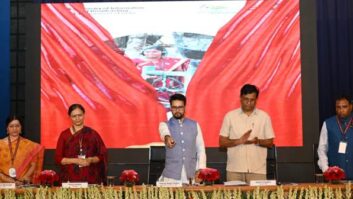
Morning show host, Soumya Jha interviews a media
expert on Gurgaon ki Awaaz, a community radio
station in the National Capital Region of Delhi.
Photos courtesy of UNESCO Chair on Community Media
NEW DELHI — Following the change in the country’s government earlier this year, the Indian Information and Broadcasting Ministry has ordered that its Electronic Media Monitoring Centre (EMMC) begin real-time broadcast radio monitoring as soon as practically possible.
The organization checks the contents of broadcast programming for compliance against the Indian broadcast content and advertising codes. This new policy has been gradually implemented over the recent months.
The EMMC already collects and analyzes the output of some 300 of India’s nearly 800 television stations, but the additional monitoring, initially of more than 100 private commercial FM stations and some 30 or more or the longest established nonprofit community radio stations, on a 24-hour, seven-day-a-week basis, will demand considerable additional resources.
OVERCOMING OBSTACLES
It will be particularly challenging when it comes to retrieving signals from some of the more rural community services that broadcast to remote small (10- to 15-kilometer radius) areas spread out across many parts of this very large country.
The technical mechanisms that will be used to gather the various broadcast radio signals are primarily based on broadband Internet capture and streaming of real-time audio. Such an approach will work where suitable infrastructure exists and where electrical power and telecommunications networks are generally reliable.
However, in parts of India, even in some of the large cities, this is not always the case and any power outages will inevitably degrade the ability of the EMMC to capture station outputs comprehensively. In certain rural areas, alternative approaches may be required, because fixed broadband infrastructure and even mains electricity are not universally available.
Assuming that the various practical technicalities of capturing station outputs are successfully overcome, the EMMC is also likely to encounter subsequent challenges when it comes to translating the many and various minority languages used on some stations.
Given the scale of monitoring proposed, it seems highly unlikely that EMMC staff will always be capable of fluently understanding all of the spoken word content being broadcast. Under such circumstances, when concerns are raised, it is likely that recordings may require further analysis by specialist linguists.
Established in 2008, as a result of government policy developments, the EMMC is currently enjoying a period of considerable expansion. As well as the introduction of broadcast radio monitoring, on the television side, the number of stations monitored is expected to double to some 600.
MORE COMMUNITY STATIONS
At present, approximately 100 people are employed at the EMMC central office in Soochna Bhawan, New Delhi, where they work around the clock in eight-hour shifts. Initially, around 15 members of staff are expected to take responsibility for radio monitoring. The group’s 2013–14 operational cost of INRs717 million (approx. US$11.7 million) is expected to almost double in 2014–15 to INRs1,375 million (approx. US$22.4 million).
The ministry has been careful not to claim that all licensed broadcasters will be comprehensively monitored immediately, suggesting that the output of “selected” stations will analyzed in the first instance. If comprehensive monitoring is the longer-term goal, then the EMMC is going to need to grow considerably more over the coming years.
At present, India already has well over 170 operational community radio stations, and the government in New Delhi has also issued permissions for up to a further 400 new stations. Clearly planning to extend the sector still further, this year’s central government budget included INRs1,000 million (approx. US$16.3 million) which Finance Minister Arun Jaitley announced would be used to “support about 600 new and existing community stations” in a move intended “to encourage growth in this sector.”

A Radio Bundelkhand community radio reporter recording a field interview in a village in central India.
Prior to the announcement of this new policy, private commercial radio stations were expected to store 90 days of output recordings for delivery to the EMMC as and when required, but community radio broadcasters were not being routinely monitored at all by the Indian state.
Because there has been no suggestion that any serious licensing violations have been occurring, it is not yet clear what the driver behind this new policy might be. However, the fact that stations in more remote areas are currently almost entirely beyond any form of practical regulatory oversight could well be a factor.
In terms of wider policy issues, the introduction of centralized monitoring of radio outputs may however be linked to helping advance the issue of news and current affairs broadcasting on the country’s private and community radio stations.

RJ Amit records a show at community station Radio Must in Mumbai.
BROADCAST NEWS?
At present, the government’s All India Radio (AIR) is the only terrestrial broadcaster permitted to provide such output, but Information and Broadcasting Minister Prakash Javadekar speaking in Mumbai, asked “why should FM channels be banned from broadcasting news? EMMC is considering allowing privately-owned FM radio channels to start their own news.”
A report published at the end of August by the Telecom Regulatory Authority of India (TRAI), “Recommendations on Issues Related to Community Radio Stations,” concluded that, in future, community stations should be permitted to rebroadcast the news outputs of AIR and be permitted to accurately translate such news into relevant local languages and dialects.
However, although the authority recognized the importance of self-generated local news and current affairs for community radio broadcasters, it noted the “scope for misuse of this facility” and concluded that in absence of an “effective monitoring mechanism” it should not yet be permitted.
The prohibition on news and current affairs broadcasting has been a source of considerable contention since experimental private commercial radio stations began operating in India as long ago as the early 1990s.
It is particularly problematic for community stations, which have now been operating in the country for over 10 years. These stations typically focus on fostering community cohesion and development, broadcasting a wide variety of locally relevant information in support of such aims.
Observers point out that if the Indian government is really serious about driving forward the development of this sector, then this is an issue that needs to be resolved as quickly as possible.
Lawrie Hallett researches and teaches radio broadcasting at the University of Bedfordshire in the United Kingdom, he can be contacted by e-mail: [email protected].










